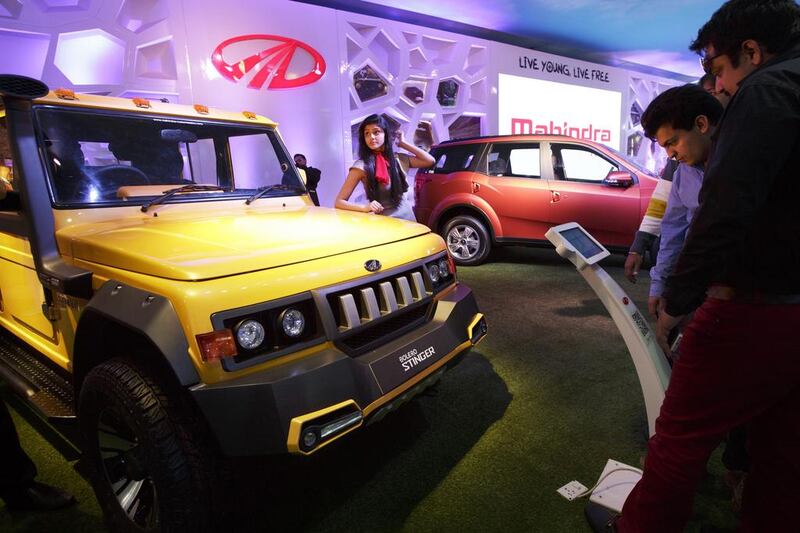Mumbai // There has been an array of car launches in India over the past few days amid glitz, fanfare and the presence of Bollywood stars at the Auto Expo, which draws to a close today.
Both Indian and foreign brands stepped up a gear with their unveilings at the biennial motor show, held in the outskirts of New Delhi, in an effort to impress and grab a share of a market in which competition between manufacturers has become increasingly fierce.
All this is at a time when car sales have spluttered and the country’s economic growth has slowed to near decade-low levels. The potential returns are huge, however. India has a population of more than 1.2 billion, but only 12 out of every 1,000 own a car, according to data from the World Bank.
Among the launches at the Auto Expo was the Range Rover LWB from Jaguar Land Rover, owned by India’s Tata Motors, and unveiled by the film actress Priyanka Chopra.
Maruti Suzuki, meanwhile, launched its sedan Ciaz model. Renault used the show as a stage for the global launch of its futuristic concept car KWID, while Ford unveiled a series of cars. They are all among the global car makers that have collectively invested billions in the Indian market and remain committed to the market despite the downturn.
Car sales in India last year slumped for the first time in 11 years amid slowing economic growth, high inflation and interest rates and rising fuel prices. Sales fell to 1.8 million, down almost 10 per cent over the year before, according to figures from the Society of Indian Automobile Manufacturers (Siam). Car manufacturers in India, including Maruti Suzuki and Mahindra & Mahindra, last year temporarily shut factories in an effort to clear inventories as car sales slowed.
Crisil Ratings says that car makers in India are being forced to spend more on product development and technology because of the “heat of the competition”, despite the slowdown.
“Domestic [carmakers] are being compelled to invest in new product launches and upgrade technology because of intense competition,” says Pawan Agrawal, the senior director at Crisil Ratings.
“As a result, their capital spending as a percentage of revenue will increase about 100 basis points to almost 6 per cent in this fiscal from about 5 per cent two years back.”
Its analysis of 11 manufacturers that it rated in the automobile sector, accounting for two-thirds of domestic sales, shows they will reach a total capital expenditure of 130 billion rupees (Dh7.66bn) in the current financial year, which runs through next month. That represents “10 per cent more than last [year], even as sales of passenger and commercial vehicles are expected to decline 9 per cent”, Crisil says.
“The sector’s competitive intensity has increased with more and more global auto majors pitching tent, driven in by India’s long-term growth prospects,” it adds. “Subsidiaries of global auto players such as Volkswagen and Daimler will continue to derive significant business and financial support from their parents, which consider India as a long-term bet.”
Mitul Shah, an auto analyst at Karvy Stock Broking, says that the industry could pick up later in year, although the environment remains weak.
“The overall industry is in a very bad situation,” he says. “The slowdown has continued from the last three or four months. Because of the new launches announced in the Auto Expo there could be some improvement in the volume on the sales front.
“However, we expect that [during the next financial year’s] first half there would a recovery and in the second half will be a strong bounce back in the volume, mainly because of the healthy crop output and the election year wherein government spending as well as rural spending increases sharply,” Mr Shah adds. “Basically because of the economic slowdown and the economic situation there is a subdued volume from the last year, year and a half, which should bounce back strongly.”
While high inflation meant that the central bank increased interest rates last month, Mr Shah says that inflation and rates are expected to come down later in the year.
“Food inflation comes down – there’s more money in the hands of the people and more demand for vehicles,” he says.
Fiat Chrysler described India as “one of the most strategic markets” for the company as it unveiled new models for the domestic market at the show, including its Abarth 500 car and the Fiat Avventura, which made its global debut in India.
“The introduction of new products for the Indian market is in line with our long-term strategy, which puts us in a strong position to penetrate the market,” says Nagesh Basavanhalli, the company’s president and managing director in India. “Opening 100 exclusive dealership across the country in a span of one year is a testament to this commitment.”
Indian companies, meanwhile, are expanding their range of models in an effort to drive sales.
“Indian auto makers are implementing strategies to boost earnings in a difficult environment and to improve their competitive positioning to drive longer-term growth,” says Abhijeet Naik at CLSA, a brokerage and investment group. “Most auto players are focusing on expanding their product ranges by targeting ‘white spaces’ – where they have little or no presence – and are upgrading their existing models to grow volume in a subdued market.”
Maruti Suzuki, for example, is focusing increasingly on the SUV sector, where it has a low market share.
Mr Naik adds that demand could be set to pick up. “Indian auto demand has been in the doldrums for the past three years, but the recent improvement in two-wheeler demand suggests that a recovery might be close,” he says.
Car companies are also looking at rural areas, where penetration of cars is extremely low and spending power has grown.
“Cars are still considered to be a luxury product in many rural areas and villages … but with the car makers increasing their focus and their network in this remote region, they’ll bring the interest among these people and help to change the lifestyle to some extent,” Mr Shah says. “They’ll create the demand for vehicles in the rural areas.”
But the battle for customers will continue, as both global and Indian manufacturers race to tap the latent demand.
“The competition has been increasing over the past few years, particularly the last four or five years where all these new players have entered, whether it’s Ford, Renault or Nissan, and many other[s],” says Mr Shah. “They have been establishing themselves with new launches at regular intervals, so this has created competition as well as a tough situation for existing Indian carmakers, like Maruti Suzuki and Tata Motors. Definitely going forward it will become a very competitive situation for the car makers. The product, good features, pricing point, as well as good after-sales services – all these sectors will become more important for the growth of these companies.”
business@thenational.ae





